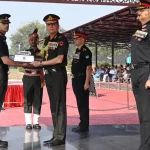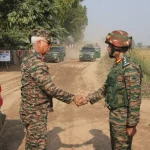The elite National Security Guard (NSG) of India holds a distinguished position within the realm of the country’s defence services. Since its inception in 1984, the NSG has been tasked with combating terrorism, handling hostage situations, and countering insurgency threats, among various other high-stakes operations. As these commandos operate in intense conditions requiring specialized skills and immense dedication, it’s crucial to understand not only the breadth of their responsibilities but also the financial compensation and career growth opportunities that accompany this challenging profession.
This comprehensive overview will delve into the NSG commando salary, highlighting pay scales, benefits, and the potential for career progression. With insights drawn from various credible sources, the following sections will elucidate the financial remuneration associated with serving as an NSG commando, framed within the broader context of their significant contributions to national security.
Historical Context
The NSG was formed following the urgent need for specialized counter-terrorism capabilities following incidents like the 1984 Operation Blue Star and the 1986 Gurdaspur train tragedy. The mandate of the NSG has evolved over the years, primarily focusing on anti-terrorism operations and hostage rescues. Operating directly under the Union Ministry of Home Affairs, the NSG is comprised of personnel from both the Indian Army and Central Armed Police Forces (CAPFs). The selection process for these commandos is rigorous, ensuring that only the most capable candidates meet the high standards of physical and mental fitness required for this role.
Given the demanding nature of their work, salaries and benefits for NSG commandos are structured to align with the high-stakes environment in which they operate.
Pay Scale Details by Rank
The salary of an NSG commando is correlated with their rank, experience, and the nature of their service background. The following table elucidates the monthly salary approximations for various ranks within the NSG:
| Rank | Monthly Salary Range (₹) |
|---|---|
| Combatised Tradesman | 30,000 – 40,000 |
| Ranger Grade II | 50,000 – 60,000 |
| Ranger Grade I | 55,000 – 60,000 |
| Assistant Commander Grade III | 60,000 – 65,000 |
| Assistant Commander Grade II | 65,000 – 70,000 |
| Assistant Commander Grade I | 70,000 – 80,000 |
| Team Commander | 80,000 – 90,000 |
| Squadron Commander | 90,000 – 1,00,000 |
| Group Commander | 1,00,000 – 1,25,000 |
| Deputy Inspector | 1,25,000 – 1,35,000 |
| Inspector General | 1,35,000 – 1,50,000 |
| Additional Director General | 1,50,000 – 2,00,000 |
| Director General | 2,00,000 – 3,00,000 |
The above figures illustrate the escalating pay scale associated with higher ranks, reflective of the increased responsibilities and operational demands at each level. Entry-level commandos earn approximately ₹30,000 to ₹40,000 monthly, while senior officials such as the Director General can earn between ₹2,00,000 to ₹3,00,000 per month.
Salary Range for Junior Ranks
For personnel entering the force from backgrounds such as state police or CAPFs, the salary scale typically varies as follows:
- Constable/Sepoy: ₹25,000 – ₹40,000
- Head Constable: ₹35,000 – ₹50,000
- Assistant Sub-Inspector (ASI): ₹40,000 – ₹60,000
- Sub-Inspector (SI): ₹50,000 – ₹70,000
- Inspector: ₹60,000 – ₹80,000
- Assistant Commandant: ₹75,000 – ₹1,00,000
- Deputy Commandant and Above: ₹1,00,000+ depending on seniority and experience
This salary structure clearly indicates that while the initial compensation may not be substantial in relation to the risks involved, the potential for financial advancement is significant as one progresses through the ranks.
Allowances and Benefits
Beyond the regular paycheck, NSG commandos receive a range of allowances that enhance their overall earnings. Some of these include:
- Risk and Hardship Allowance: A crucial financial provision accounting for the dangers faced during operations.
- Uniform Allowance: Provided for maintaining and acquiring uniforms necessary for duty, which can be costly.
- Deputation Allowance: Approximately ₹5,000 per month, given to incentivize and support those on deployment.
- Special Allowance: Following the seventh pay commission recommendations, commandos receive about ₹27,000 per month.
Moreover, NSG personnel also benefit from:
- Free Medical Treatment: Comprehensive healthcare services for themselves and their families.
- Housing Accommodations: Subsidized or free housing depending on rank and service location.
- Pension Schemes: Long-term financial security provided upon retirement or incapacity.
It’s important to note that during their training phase, recruits typically receive a stipend around ₹18,000, which sets the foundation for increased financial stability post-induction.
Career Growth and Promotion
The career trajectory for an NSG commando is structured with clear pathways and opportunities for advancement. Starting from the rank of Constable/Sepoy, an individual can progress through various ranks based on experience and operational performance:
- Constable/Sepoy
- Head Constable
- Assistant Sub-Inspector (ASI)
- Sub-Inspector (SI)
- Inspector
- Assistant Commandant
- Deputy Commandant
- Commandant
- Higher ranks: Inspector General, Additional Director General, and Director General
Promotions are generally determined by the cumulative experience, seniority, and exemplary performance in operations. Notably, exceptional personnel may be eligible for expedited promotions, particularly if they demonstrate outstanding skills during critical missions.
As commandos ascend the ranks, salaries reflect not only their enhanced status but also the increasing responsibilities inherent to their positions. For example, higher ranks, such as Major General, can earn monthly salaries ranging from ₹2,00,000 to ₹2,24,400.
Case Studies or Real-world Applications
The operation and performance of NSG commandos have become emblematic of their resilience and heroism, showcased during high-profile missions. For instance, the NSG’s successful operation during the 2008 Mumbai attacks demonstrated the immense skill and training of these commandos. They swiftly and effectively neutralized threats in commercial establishments and hotels under siege, showcasing their urgency and tactical proficiency.
Such high-pressure operations justify the compensation and allowances afforded to NSG personnel. The financial structure not only recognizes their contributions but also aims to attract and retain skilled individuals who can manage the intense pressures of their tasks.
Statistical Data and Research Insights
Research indicates that around 90% of India’s counter-terrorism operations leverage the capabilities of the NSG. Additionally, the unit has been involved in over 200 significant operations since its inception, emphasizing the organization’s critical role in national safety and security.
According to reports, NSG commandos face an intensified threat level, amplified by evolving terrorism tactics and regional unrest. A report from the Ministry of Home Affairs states that increased funding and resources, including competitive salary structures, are essential in enhancing operational effectiveness.
Challenges and Solutions
Despite the robust salary and benefits, NSG commandos encounter various challenges:
- Mental and Physical Stress: The demanding nature of tasks can lead to psychological stress.
- Public Perception: Misunderstandings about their roles can create societal pressures that impact morale.
Potential Solutions:
- Mental Health Support: Establishing psychological support frameworks can help personnel deal with the emotional toll of their work.
- Public Engagement Initiatives: Conducting community outreach programs can bridge any gaps in public understanding, fostering transparency and support for the NSG’s work.
Future Trends and Predictions
As geopolitical tensions evolve and the nature of threats continues to change, the NSG must adapt its operational strategies and training regimens accordingly. There is an anticipation that the government’s investment in elite forces such as the NSG will increase, allowing for more advanced training methodologies and technological integration into operations.
Additionally, the push for modernization and maintaining an agile response mechanism may lead to higher budget allocations towards both salaries and operational readiness. The integration of technology in training, including simulation-based exercises and advanced weaponry, could further enhance the effectiveness of NSG personnel.
Conclusion
The NSG commando salary structure encapsulates the elite status and critical nature of the work they perform. The varying pay scales from approximately ₹25,000 for entry-level personnel to over ₹3,00,000 for senior officers reflect their specialized skill sets, extensive training, and essential role in safeguarding national security.
With an average annual salary of around ₹10 lakh, combined with substantial allowances and benefits, the compensation package is designed to recognize and reward their dedication. As the landscape of national and global security evolves, so too must the NSG, ensuring robust pathways for career growth and advancement.
Ultimately, the continued investment in the NSG by the government of India underscores the vital importance of this elite force, both in terms of human resources and financial commitment to national stability. Commandos are the frontline defenders of our nation’s security, and understanding their salary and benefits sheds light on the profound responsibilities they uphold to protect and serve.
For those seeking a career in this noble field, resources such as SSBCrack and SSBCrackExams can provide invaluable guidance and information, supporting aspirants on their journey to joining the ranks of India’s bravest defenders.












